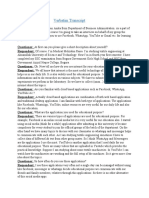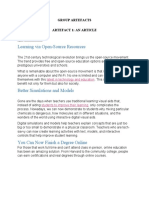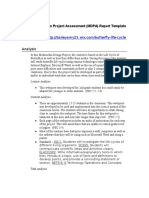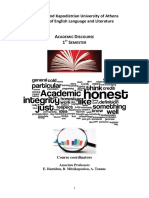MITx The Learning Revolution - Transcript
Uploaded by
rishitMITx The Learning Revolution - Transcript
Uploaded by
rishitSCRIPT OF TALK
TITLE: MITx The Learning Revolution SPEAKER: Prof. Sanjay Sharma
NARRATION:
Hello!! My name is Sanjay Sarma, I am a professor of Mechanical Engineer at MIT and the
Director of Digital Learning at MIT. The office of digital learning at MIT consists of several
groups one of which is OpenCourseWare and the other is MITx which is what I'll be talking but
mostly today I have prepared this video for Professor T.V Prabhakar who was my professor
when I was a student at IIT Kanpur over twenty years ago. So, let me start by composed about
edX as you will have heard by now in professor provocateurs course Moocs, Moocs on Moocs
edX is a not-for-profit online site that was designed for learners worldwide and it was
established first by MIT and then it was spun out of MIT into edX with an investment from both
MIT and Harvard and it now counts amongst its member many other top universities in the
world Berkeley, Caltech, IIT Bombay, Tsinghua and so on. The president of edX is professor
Annant Aggarwal who is actually still a professor at MIT and is now on leave and he's the CEO of
edX and he's the man who actually founded the original MITx project which I'll talk about more
in a minute.
The edX platform is open-sourced under the open edX pronoun which means that you can
download it and install it on your computer if you want but the edX.org website is the marquee
installation and that's where most of these top universities go to put up their up massive open
online courses for publication edX today has in nearly three million enrollees from over 195
countries and it's growing very rapidly in very excited about it some should say that I sit on the
board of edX and I'm a big believer in digital learning and let me tell you about the history first
you see edX was a established as I said first it was a project at MIT that was triggered by
Professor Aggarwal. Annant taught a course 6W2x which is circuits and systems to the world
and he ended up getting a hundred fifty-five thousand students the course was launched in
1
March of 2012 and by the summer 2012 MIT had realized that this was a big deal. So MIT went
Page
MOOC on MOOC SEPT 2014IITK-COL CC BY SA.
out to the colleagues at Harvard and we founded edX but at that time we also decided to split
the functions a little bit you see when usually the MITx was launched at MIT it did two things
one is it produce content but it also created the platform on which the content run so when we
created edX carved out content production left it with an MIT and so MITx think of it as Disney
we make the movies and edX is the platform it’s like a theater and edX is now an independent
not-for-profit run by MIT and Harvard and the CEO's professor Aggarwal. So, the MITx piece the
production piece still resides with an MIT and reports into my office now obviously the launcher
for MOOCs is exciting to us that follows in a long tradition of MIT doing outreach work for the
world for example in the early 2000's MIT launched OpenCourseWare which was a gift by MIT
to the world of its intact curriculum. Today, OpenCourseWare receives more than two and a
half million views monthly into unique views from learners around the world and so. Similarly,
edX is a gift to the world but since the edX software is open source and in fact the reason it's
open source is so that universities can actually use the edX software on campus and I want to
give you some insights into why we do that and what some of the outcomes or in the next few
slides so edX when my office was created we took the open source software and we ran a
version of it on campus and we made it available to our professors and I have to say that we
were absolutely blown away by the adoption on campus it was tremendous professors, started
using it inside the courses and the number of course is pretty much doubled every semester
starting in the fall of 2012 through the spring of 2014 and we have 4500 undergrads about and
more than half of them now have used the edX platform through their classes. I'm not talking
about going to edx.org. I’m talking about taking it or using this platform intrinsically through
their internal classes because the professors have started using the edX platform on campus
and this is the growth in the number of courses. It is said it doubled in every semester so what
I’m going to talk about now is why, why is this happening why is online learning such a big deal
on campus. We hear about learning in the context of massive open online courses but why on
campus. The reason is because at some deep level we believed that we are cracking the code
on learning I mean these are early days but it's very exciting to see what the possibilities are
and or talk to you a little bit about the pedagogy that online learning enables you to see.
2
There's a lot of research it's not recent actually goes back almost 50 years that shows that long
Page
MOOC on MOOC SEPT 2014IITK-COL CC BY SA.
lectures that his lectures that go you know ninety minutes sixty minutes are not efficient and
there's a recent publication in the proceedings of the National Academy of Sciences in the
United States that further emphasize that lectures kind of don't work, in the reason frankly is
because they are one-way and students are passive and you know of course one can always
wave a finger at students and say you must pay attention and they assure but the fact of the
matter is attention spans of most individuals is in the brain is just but six to eight minutes
maybe 10 minutes what we have learnt. In the last few years is the best way to achieve
learning actually is to slice everything into very very thin slices in other words don't do if
possible a one-hour lecture ninety minute lecture do a 10 minute lecture and instantly give
students feedback about whether they understood the material or not by asking them
questions now we try to do that in regular lectures today with something called active but that
is not that easy to do because you got to break the flow of the lecture and so on. But with
online that becomes very possible. So here you saw a video of Professor Eeric Lander giving a
lecture and it's transcribed on biology and his lectures are really very captivating but he keeps
into under 10 minutes and instantly we then pop up a feedback window. Now, this feed back
window is not from biology this from another course this is from Annant’s Electrical Engineering
course and so instantly at the end of a 10 minute lecture we ask questions. And now student is
force to retrieve his or her learning from that 10-minute video from short term memory. Now if
they don't know the answer they can go back and watch the video again if they don't know the
answer then this act of assessing it’s called interpolated learning it forces the student at some
level to sort of transfer stuff from short term memory into long-term memory by re-exploring
quickly what they learnt so this business of quickly cycling between quick learning modules and
then quick assessments at some level. Not for long time this works but online we can really do
at a very practical level it's very hard to do a 10 minute lecture in a regular classroom but with
online that is how we operate and then the next thing you can do is go straight to practice
which is put the student in the lamp put the student in discussion and then have them actually
practice what they learn. So, for example they learn biology perhaps have them go do some
observations go to assimilation if they've learnt control, quick lecture on controls quick
3
assessment then instantly applied that within a day or two to for example building a robot and
Page
MOOC on MOOC SEPT 2014IITK-COL CC BY SA.
having it move around. At once, if you start doing that you start getting some really amazing
learning outcomes I say again this is not new known as a long time. But with on line it becomes
possible now how good that is some were put up a very very complicated graph bear with me
here. This is from Professor Michael Seamark this is a class that he taught in the fall of 2013 on
Solid State chemistry it’s a famous class at MIT and down let me explain what these results
show, what he did was that he replaced all the homework’s, all the assignments and all the
exams in this class with weekly online quizzes with instant feedback and every quiz was
randomized. So if two students took the quiz they'll get different questions and if the same
student to the quiz twice they would get different questions but I'll come back to why the same
student might take the question twice in a second. So, what we do here is first of all he spread
the course in two modules for example the first module is on atomic structures now ignore the
red just look at the blue and the green. The blue is the number of students who would have
scored a 100 percent on that topic a he explains in this paper the old way. The course is taught
which regular lectures are and green is the number of students who scored a 100 percent on
that topic than new way which is where he had dozens to be back and you can see the results
are very remarkable actually. the number of students to score you know hundred percent is
very high the new way. the way he ran the class was like say if the student took a quiz let's say I
took a quiz on Thursday it's a proctored quiz its online setting I’ll go and I’ll show my ID. I’ll take
the exam in an online setting I get a score and if I don't like the score I can actually scratch it
and then I get locked up for 24 hours and I can go and talk to the TA I can take the exam again
or the quiz again so the idea here as I can keep trying until I get my level of knowledge up but in
the process of taking the exam and being forced to review what I don't know and then don’t
clarify my doubts so it forces me to actually do well on the exam. So the result structure
tremendous now just to finish this description as graphs the blue was the old star the green was
the new star. How many students scored a 100 percent the red is the another student score
eighty percent in the old star so what this shows is that in all of you know of regular lectures
with feedback you know through homeworks which comes to two or three weeks later a much
smaller fraction of students even knew New eighty percent of the material compared to the
4
number of students who get a hundred percent so that is you know just the beginning of how
Page
MOOC on MOOC SEPT 2014IITK-COL CC BY SA.
online is impacting as a campus now when we first started using online material on campus
students were somewhat suspicious of it sort of change they didin’t like it too much last
semester we taught another class 8.02x using the lectures the very famous Professor Walter
Lewin and some other online material and we also used more importantly instant feedback and
what you can see is that students have been to like this a lot this saying yup I prefer to do 8 or 2
using instant feedback on MITx and should continue to use MITx.
Over alluring majority say yes should other courses use online ad again the majority of students
say yes instant feedback this is one of the comments instant feedback equals better study
habits and I'm able to retain the material the right way so this is becoming something of a
theme sort of a new style of teaching that we're a very excited about now this is not new to
MIT. MIT has a long history of learning by doing so if you a look at the MIT logo there’s a man
with a book but is also a man with a sledgehammer and the reason is that the founding
principle at MIT was to bring mind and hand together men's as Manas as it says down here. so
for us this is all very natural but it's also very heartening to see how online education online
digital learning tools have become a very important part of the way education occurs on
campus at MIT so look I’II stop with that I’II obey my own that lecture should be brief I've
already gone took 14 minutes which is long but again I hope you enjoy this and thank you very
much.
Bye bye
5
Page
MOOC on MOOC SEPT 2014IITK-COL CC BY SA.
You might also like
- Detailed Lesson Plan In: ENGLISH For Grades 7 (Quarter 1-Week 1-SY 2020-2021)No ratings yetDetailed Lesson Plan In: ENGLISH For Grades 7 (Quarter 1-Week 1-SY 2020-2021)7 pages
- Verbatim Transcript: Questioner: RespondentNo ratings yetVerbatim Transcript: Questioner: Respondent5 pages
- UCLA MOOC Summit Jan 2013 Revised TranscriptNo ratings yetUCLA MOOC Summit Jan 2013 Revised Transcript33 pages
- Universidad Capitan General Gerardo Barrios: San Miguel 5Th, 2014No ratings yetUniversidad Capitan General Gerardo Barrios: San Miguel 5Th, 20148 pages
- Instant Access to Project based learning for gifted students a step by step guide to PBL and inquiry in the classroom c Todd Stanley Second Edition Todd Stanley ebook Full Chapters100% (7)Instant Access to Project based learning for gifted students a step by step guide to PBL and inquiry in the classroom c Todd Stanley Second Edition Todd Stanley ebook Full Chapters67 pages
- Online Education: ..... Done by AVINANDAN PALNo ratings yetOnline Education: ..... Done by AVINANDAN PAL17 pages
- Field Study 1: Lesson 2: The Virtual Learning Environment I. Learning CompassNo ratings yetField Study 1: Lesson 2: The Virtual Learning Environment I. Learning Compass10 pages
- Ajeng Cempaka Lestari EAP Composition II Ms. Kay Alcorn BrainstormNo ratings yetAjeng Cempaka Lestari EAP Composition II Ms. Kay Alcorn Brainstorm8 pages
- Instant Download Project based learning for gifted students a step by step guide to PBL and inquiry in the classroom c Todd Stanley Second Edition Todd Stanley PDF All ChaptersNo ratings yetInstant Download Project based learning for gifted students a step by step guide to PBL and inquiry in the classroom c Todd Stanley Second Edition Todd Stanley PDF All Chapters67 pages
- Online Learning: To Persuade The Readers or Listeners That Something Should or Should Not Be The Case100% (1)Online Learning: To Persuade The Readers or Listeners That Something Should or Should Not Be The Case1 page
- m11 Multimedia Video Lesson Idea Template 2021No ratings yetm11 Multimedia Video Lesson Idea Template 20212 pages
- m11 Multimedia Video Lesson Idea Template 2021No ratings yetm11 Multimedia Video Lesson Idea Template 20213 pages
- Web 2.0 Communcation and CollaborationTools) LESSON IDEA TEMPLATENo ratings yetWeb 2.0 Communcation and CollaborationTools) LESSON IDEA TEMPLATE4 pages
- Liu Jianseng 13whr10938 rml3 Assignment1No ratings yetLiu Jianseng 13whr10938 rml3 Assignment17 pages
- Multimedia Audio or Video Lesson Idea Avery OrrNo ratings yetMultimedia Audio or Video Lesson Idea Avery Orr3 pages
- Universidad Capitan General Gerardo BarriosNo ratings yetUniversidad Capitan General Gerardo Barrios9 pages
- Instant ebooks textbook Project based learning for gifted students a step by step guide to PBL and inquiry in the classroom c Todd Stanley Second Edition Todd Stanley download all chapters100% (1)Instant ebooks textbook Project based learning for gifted students a step by step guide to PBL and inquiry in the classroom c Todd Stanley Second Edition Todd Stanley download all chapters67 pages
- Multimedia Design Project Assessment (MDPA) Report Template: Product URL: AnalysisNo ratings yetMultimedia Design Project Assessment (MDPA) Report Template: Product URL: Analysis4 pages
- Portraying A Web-Driven Lecturer: Lesson Learned From An Indonesian Accounting ClassNo ratings yetPortraying A Web-Driven Lecturer: Lesson Learned From An Indonesian Accounting Class4 pages
- LM 5040 Integrating Technology in The School FinalNo ratings yetLM 5040 Integrating Technology in The School Final5 pages
- Nick's Learning Design Solution TemplateNo ratings yetNick's Learning Design Solution Template5 pages
- English Trends and Issues in Curriculum Development DownSub.comNo ratings yetEnglish Trends and Issues in Curriculum Development DownSub.com32 pages
- m04 Instructional Software Lesson Idea TemplateNo ratings yetm04 Instructional Software Lesson Idea Template2 pages
- 26-IERJ20183388959426+-+Online+-+Sundaram+NishadNo ratings yet26-IERJ20183388959426+-+Online+-+Sundaram+Nishad2 pages
- 50 Things You Can Do With Google ClassroomNo ratings yet50 Things You Can Do With Google Classroom110 pages
- The Ultimate Guide To Online Learning ToolsNo ratings yetThe Ultimate Guide To Online Learning Tools54 pages
- Article Summaries 1 Running Head: ARTICLE SUMMARIESNo ratings yetArticle Summaries 1 Running Head: ARTICLE SUMMARIES18 pages
- This Study Resource Was: Engineering:: Turbo Machines Heat Flow MeasurementNo ratings yetThis Study Resource Was: Engineering:: Turbo Machines Heat Flow Measurement3 pages
- Self Assessment Quiz - 65th, 66th and 67th IIRS Outreach ProgrammeNo ratings yetSelf Assessment Quiz - 65th, 66th and 67th IIRS Outreach Programme3 pages
- This Study Resource Was: Engineering:: Turbo Machines New Rotodrdynamics SoftwareNo ratings yetThis Study Resource Was: Engineering:: Turbo Machines New Rotodrdynamics Software3 pages
- This Study Resource Was: Engineering:: Turbo MachinesNo ratings yetThis Study Resource Was: Engineering:: Turbo Machines3 pages
- Placement Opportunities: Caterpillar: Confidential GreenNo ratings yetPlacement Opportunities: Caterpillar: Confidential Green4 pages
- 15 Ways To Boost Your Personal Brand On LinkedIn100% (1)15 Ways To Boost Your Personal Brand On LinkedIn17 pages
- Transportation Planning and Engineering: Postgraduate Taught Courses 2020No ratings yetTransportation Planning and Engineering: Postgraduate Taught Courses 20206 pages
- Government Open Data License - India National Data Sharing and Accessibility Policy Government of IndiaNo ratings yetGovernment Open Data License - India National Data Sharing and Accessibility Policy Government of India4 pages
- Name: Kyle Joshua Verdida Bsed-3 Step2. Analyzing The Salient Parts of Lesson PlanNo ratings yetName: Kyle Joshua Verdida Bsed-3 Step2. Analyzing The Salient Parts of Lesson Plan5 pages
- Curriculum Development Prof Ed LET ReviewerNo ratings yetCurriculum Development Prof Ed LET Reviewer7 pages
- The Blessings of Young Dreams: Learn More About The CERN ProgramNo ratings yetThe Blessings of Young Dreams: Learn More About The CERN Program23 pages
- Matt Tedeschi's Open Letter To The ST Ignatius Community100% (2)Matt Tedeschi's Open Letter To The ST Ignatius Community2 pages
- Calendar of Activities 2017-2018 - Institutional CalendarNo ratings yetCalendar of Activities 2017-2018 - Institutional Calendar8 pages
- The Demands of Society From The Teacher As A Professional73% (11)The Demands of Society From The Teacher As A Professional46 pages
- Instructional Lesson Plan: I. Purpose of The LessonNo ratings yetInstructional Lesson Plan: I. Purpose of The Lesson6 pages
- Detailed Lesson Plan In: ENGLISH For Grades 7 (Quarter 1-Week 1-SY 2020-2021)Detailed Lesson Plan In: ENGLISH For Grades 7 (Quarter 1-Week 1-SY 2020-2021)
- Universidad Capitan General Gerardo Barrios: San Miguel 5Th, 2014Universidad Capitan General Gerardo Barrios: San Miguel 5Th, 2014
- Instant Access to Project based learning for gifted students a step by step guide to PBL and inquiry in the classroom c Todd Stanley Second Edition Todd Stanley ebook Full ChaptersInstant Access to Project based learning for gifted students a step by step guide to PBL and inquiry in the classroom c Todd Stanley Second Edition Todd Stanley ebook Full Chapters
- Field Study 1: Lesson 2: The Virtual Learning Environment I. Learning CompassField Study 1: Lesson 2: The Virtual Learning Environment I. Learning Compass
- Ajeng Cempaka Lestari EAP Composition II Ms. Kay Alcorn BrainstormAjeng Cempaka Lestari EAP Composition II Ms. Kay Alcorn Brainstorm
- Instant Download Project based learning for gifted students a step by step guide to PBL and inquiry in the classroom c Todd Stanley Second Edition Todd Stanley PDF All ChaptersInstant Download Project based learning for gifted students a step by step guide to PBL and inquiry in the classroom c Todd Stanley Second Edition Todd Stanley PDF All Chapters
- Online Learning: To Persuade The Readers or Listeners That Something Should or Should Not Be The CaseOnline Learning: To Persuade The Readers or Listeners That Something Should or Should Not Be The Case
- Web 2.0 Communcation and CollaborationTools) LESSON IDEA TEMPLATEWeb 2.0 Communcation and CollaborationTools) LESSON IDEA TEMPLATE
- Instant ebooks textbook Project based learning for gifted students a step by step guide to PBL and inquiry in the classroom c Todd Stanley Second Edition Todd Stanley download all chaptersInstant ebooks textbook Project based learning for gifted students a step by step guide to PBL and inquiry in the classroom c Todd Stanley Second Edition Todd Stanley download all chapters
- Multimedia Design Project Assessment (MDPA) Report Template: Product URL: AnalysisMultimedia Design Project Assessment (MDPA) Report Template: Product URL: Analysis
- Portraying A Web-Driven Lecturer: Lesson Learned From An Indonesian Accounting ClassPortraying A Web-Driven Lecturer: Lesson Learned From An Indonesian Accounting Class
- LM 5040 Integrating Technology in The School FinalLM 5040 Integrating Technology in The School Final
- English Trends and Issues in Curriculum Development DownSub.comEnglish Trends and Issues in Curriculum Development DownSub.com
- Article Summaries 1 Running Head: ARTICLE SUMMARIESArticle Summaries 1 Running Head: ARTICLE SUMMARIES
- This Study Resource Was: Engineering:: Turbo Machines Heat Flow MeasurementThis Study Resource Was: Engineering:: Turbo Machines Heat Flow Measurement
- Self Assessment Quiz - 65th, 66th and 67th IIRS Outreach ProgrammeSelf Assessment Quiz - 65th, 66th and 67th IIRS Outreach Programme
- This Study Resource Was: Engineering:: Turbo Machines New Rotodrdynamics SoftwareThis Study Resource Was: Engineering:: Turbo Machines New Rotodrdynamics Software
- This Study Resource Was: Engineering:: Turbo MachinesThis Study Resource Was: Engineering:: Turbo Machines
- Placement Opportunities: Caterpillar: Confidential GreenPlacement Opportunities: Caterpillar: Confidential Green
- Transportation Planning and Engineering: Postgraduate Taught Courses 2020Transportation Planning and Engineering: Postgraduate Taught Courses 2020
- Government Open Data License - India National Data Sharing and Accessibility Policy Government of IndiaGovernment Open Data License - India National Data Sharing and Accessibility Policy Government of India
- Name: Kyle Joshua Verdida Bsed-3 Step2. Analyzing The Salient Parts of Lesson PlanName: Kyle Joshua Verdida Bsed-3 Step2. Analyzing The Salient Parts of Lesson Plan
- The Blessings of Young Dreams: Learn More About The CERN ProgramThe Blessings of Young Dreams: Learn More About The CERN Program
- Matt Tedeschi's Open Letter To The ST Ignatius CommunityMatt Tedeschi's Open Letter To The ST Ignatius Community
- Calendar of Activities 2017-2018 - Institutional CalendarCalendar of Activities 2017-2018 - Institutional Calendar
- The Demands of Society From The Teacher As A ProfessionalThe Demands of Society From The Teacher As A Professional
- Instructional Lesson Plan: I. Purpose of The LessonInstructional Lesson Plan: I. Purpose of The Lesson













































































































